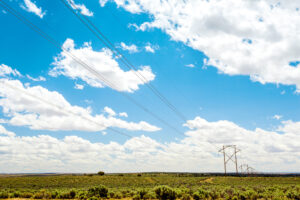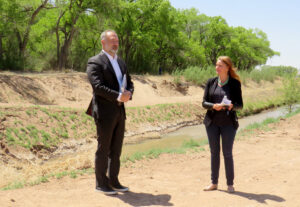The selenium battle of Lake Koocanusa

In December 2020, after five and a half years of meetings with government agencies and tribes on both sides of the border, Montana arrived at a set of standards it deemed necessary to protect Lake Koocanusa, a 92-mile reservoir that straddles the U.S.-Canada border, from selenium pollution flowing into Montana from British Columbia’s largest coal mining operation.
At the time, the Montana Department of Environmental Quality said the new standards would protect the lake and the Kootenai River immediately downstream from selenium, a chemical element that even in small quantities can hamper reproductive success in fish and lead to spinal, facial and gill deformities. DEQ said an extensive process replete with collaboration and public engagement was used to arrive at the standards, which the state Board of Environmental Review approved in the final month of former Democratic Gov. Steve Bullock’s second term. The new standards became law when the federal agency that administers the Clean Water Act signed off on them two months later.
But in recent months, a Canadian mining company with big plans to expand its coal mining footprint has thrown a wrench into what appeared to be a settled issue by asserting that state agencies broke Montana law by adopting a standard for Lake Koocanusa of 0.8 micrograms of selenium per liter of water. Over the past nine months, Teck Coal, a multi-billion-dollar subsidiary of mining giant Teck Resources, has brought high-level executives and attorneys to meetings before environmental regulators and policymakers in Helena and Libby in an attempt to invalidate one of the eight Montana standards — the one that defines an acceptable amount of selenium in Lake Koocanusa.
Teck’s effort takes aim at both the science used to reach the Lake Koocanusa standard and the process by which it was adopted. The company has hired an expert to challenge how the model was used to arrive at 0.8 micrograms, questioned the utility of recent fish samples showing selenium levels exceeding the threshold deemed safe by state and federal environmental regulators, and highlighted its $1.2 billion investment in water treatment to reduce the amount of selenium reaching watersheds.
At the heart of Teck’s multipronged effort to overturn the Lake Koocanusa standard is a process claim.
Teck maintains that in 2020, the Montana Board of Environmental Review, a quasi-judicial body that adjudicates environmental permit disputes, erred by signing off on a standard for selenium concentration in Lake Koocanusa because it is more stringent than the 1.5 micrograms/liter federal guideline the EPA established for selenium pollution in lakes and slow-moving water bodies in 2016.
Teck filed a petition with BER last June arguing that the previous board’s approval of the standard runs counter to a measure state lawmakers passed in 1995 prohibiting DEQ from adopting water quality standards more stringent than analogous federal regulations. That law includes an exception for stricter standards if they’re necessary to protect public health or the environment and the agency can prove the more stringent standard is achievable with current technology.
Teck has found a receptive audience for its campaign in both the Lincoln County Commission and the BER, which is now mostly composed of members appointed by Montana’s current governor, Greg Gianforte. In October, the Lincoln County Commission submitted its own petition challenging the 0.8 standard, which was later consolidated with Teck’s. Last month BER sided with Teck in its 5-2 vote finding that the standard didn’t pass the stringency test, effectively reversing the previous board’s decision. BER directed DEQ to issue written findings to explain how it arrived at the standard, why it’s necessary, and the expected economic impacts to the regulated community. DEQ issued that document April 4, and it’s now out for a 30-day public comment period.
All parties agree that the issue is complicated — two BER board members who voted with Teck described it as a “quagmire” — by the fact that Montana has no authority to regulate Teck, which mines metallurgical coal in Canada and ships it overseas for use in steelmaking. In the process of extracting that coal, Teck’s mines generate piles of waste rock that are exposed to water and air. As a result, the mine waste sheds selenium into waterways, where it enters the aquatic food chain. Once in water bodies, selenium is nearly impossible to remove, so Teck’s mitigation efforts focus on preventing it from entering water bodies in the first place.
Derf Johnson, clean water program director for the Montana Environmental Information Center, said he finds the whole debate “really bizarre,” especially since Montana stands to gain so little from loosening selenium standards.
“The only thing we’re getting out of this is pollution, and a small number of legislators and the county commissioners up in the northwest have decided that that’s totally appropriate and in fact we should get higher levels of pollution from Canadian coal,” Johnson said in an interview with Montana Free Press. “It does not make sense to me.”
Erin Sexton, a senior scientist at the University of Montana’s Flathead Lake Biological Station who’s studied British Columbia mining operations’ impact on watersheds for almost two decades, has a couple of theories about why Teck has put so much pressure on Montana. One is that more than a century ago the United States and Canada signed a treaty establishing that the two countries won’t pollute each other’s waters, and the selenium issue could create tension between the two nations. The other is that failing to meet selenium standards in downstream waters could jeopardize Teck’s proposed expansion, which includes plans to increase the footprint of one of its coal mines by nearly 18 square miles, an effort that’s estimated to extend its operational life into the 2070s.
Though Montana Fish, Wildlife and Parks has documented selenium exceedances in Koocanusa fish tissues in the past, the department’s most recent sampling effort is notable for the number of species that exceeded safe thresholds and the degree to which they were over the limit. Four of nine fish species collected in 2020 exceeded a key selenium threshold. That’s not a good look for Teck, Sexton said.
“These fish tissue concentrations are red flags — it’s data that says you’re reaching thresholds for toxicity in the watershed we know harms fish,” she said. “I don’t think that bodes well for Teck’s endeavors to expand.”
The conversation is also unfolding amid a new regulatory push in Canada and on the heels of a black eye for the company. Last year, Teck Coal agreed to pay a $60 million fine for failing to exercise due diligence to prevent selenium and calcite from leaching from its waste rock piles into waterways and settling ponds in Canada’s Elk River Valley. While the agreement specifies that the fine pertains to a decade-old violation, it was eight times higher than the second-highest fine ever levied under Canada’s Fisheries Act.
On the regulatory side, participants in the trans-border Lake Koocanusa Monitoring and Research Working Group have said that British Columbia is considering lowering its current Lake Koocanusa selenium objective from 2.0 micrograms per liter to .85 micrograms per liter. Canada lacks an enforceable legal tool like the United States’ Clean Water Act, so its objectives are closer to targets than the United States’ legal limits. Objectives do play a role in permitting, though.
In a February BER hearing, Myla Kelly, DEQ’s water quality standard’s section supervisor, told the board that her counterparts in British Columbia intend to begin the public process of adopting a 0.85 micrograms per liter standard “very soon.” In an email to MTFP, a spokesperson for the British Columbia Ministry of Environment and Climate Change Strategy said the province is working with the Ktunaxa Nation Council to develop an objective using the “best available science” and expects to start that process “later this spring.”
A comment by a Billings-based Teck attorney during that hearing also indicates the company is anxious about how Montana’s standard could influence British Columbia’s objective.
“The Board’s rulemaking record [from 2020] says this would be used to pressure British Columbia to set a standard. British Columbia issues permits that govern Teck. That is going to affect Teck Coal,” Vicki Marquis said when asked whether the company has standing to bring a claim before the board.
STANDARD-SETTING, MODELING AND FISH SAMPLES
Sen. Mike Cuffe, R-Eureka, one of the northwestern Montana politicians leading the push to redo the state’s selenium standard, said he’s worried a more stringent standard will hamper industry in the Kootenai Valley, and described the process to adopt it as “very very rushed.”
Cuffe’s house is about 1.5 miles from Lake Koocanusa. He said he’s firm in his commitment to “hold Teck’s feet to the fire,” but he’s also toured the company’s water treatment facilities and seen its investment in reducing waterborne selenium pollution.
“They have done a lot, and I appreciate that,” he said.
At a recent Lincoln County Commission meeting, a Teck representative said the company has more than 25 research and development projects underway to improve water quality, and once its fourth water treatment facility comes online later this year, it will be treating 20 millions gallons per day, a four-fold increase from its 2020 capacity.
Cuffe said he brings an industry perspective to the conversation, having worked in logging, Christmas tree and sawmill operations in northwest Montana for most of his adult life. He said he worries that an overly stringent standard will put an unwelcome burden on future Montana projects to prove they’re not going to add more selenium to the lake. (DEQ estimates that 95% of the selenium in the lake is coming from the Elk River, which accounts for about one-quarter of the lake’s volume and flows through the heart of Teck’s coal mining operation; no existing projects in Montana have been halted by the selenium rule.)
Cuffe also said the first time he heard of the 0.8 micrograms per liter standard was in a Sept. 9, 2020, Zoom meeting hosted by DEQ that was difficult to follow. By the end of that year, the standard was effectively adopted by the state.
“I’m saying, wait a minute, we have a right to understand the selenium rule,” Cuffe told MTFP. “Don’t make a recommendation without taking time so that we can understand it, step by step. That’s the way government should happen.”
That argument holds little sway with environmentalists like Johnson, who said the Koocanusa Monitoring and Research Working Group employed “one of the more thorough rulemaking processes I’ve seen in recent memory.” He’s similarly unimpressed with suggestions that industry concerns should supersede ecological considerations in the standard-setting process.
“The idea that we should move the goalposts in order to cater to and facilitate industry just completely undermines the idea of our bedrock environmental laws,” he said. “It is not a hardship for industry to make sure that they’re not going to negatively impact water quality.”
Jason Gildea, a Helena-based hydrologist and water policy adviser for the Environmental Protection Agency, supported Johnson’s description of the process during a Feb. 28 meeting before an interim legislative committee that was convened by House Joint Resolution 37 to study the selenium rule. Gildea said the Lake Koocanusa Monitoring and Research Working Group held more than 40 meetings between 2015 and 2020, including nine public meetings in Libby, Eureka, Kalispell and Helena.
Other testimony from the Feb. 28 meeting goes to the heart of another issue that’s been flagged by Teck and the Lincoln County Commissioners: whether DEQ appropriately calibrated the model it used to set its selenium standard.
A University of California, Davis, scientist named Samuel Luoma said he believes the model was inaccurately calibrated because of how it accounts for selenium accumulation among smaller organisms that fish eat. Luoma, who was hired by Teck to serve as an expert on the issue, asserts that DEQ ran the model in a way that “juggled coefficients” and “overpredicted concentrations in the food web.” He said that as a result the model arrived at a more stringent selenium standard than is necessary to protect Lake Koocanusa fish.
In response, DEQ’s Kelly told the HJ 37 committee that the science used to inform the effort was rigorously vetted, peer reviewed and developed with input from top selenium pollution researchers. She also said all members of the technical committee working on the standard were given the opportunity to provide input on the model. Luoma was not part of that committee or those discussions, she said.
UM’s Sexton said there’s plenty of evidence to suggest that current Lake Koocanusa selenium concentrations — which fluctuate seasonally, but tend to stay around 1 microgram per liter — are not protective enough.
“We’re already at that toxicity threshold for fish, so there is no scientific justification to allow for higher levels of selenium,” she said, adding that selenium will continue accumulating in the lake from decades of pollution from existing and shuttered mining operations.
One of the few points of agreement among the new standard’s proponents and opponents is that the most important data point in the conversation is the amount of selenium present in reproductive tissue — ovaries or eggs — because the earliest life stage is when fish are most sensitive to selenium exposure. If there’s too much selenium in the egg, that egg will either fail to hatch or the young fish will be so deformed that it will quickly die, Sexton said. She said selenium is sometimes called the “invisible contaminant” because it’s difficult to take stock of eggs that never hatched and tiny, deformed fish that never reached maturity.
As is the case with seven of the eight standards for Lake Koocanusa and the Kootenai River included in DEQ’s selenium rule — covering everything but concentrations in Lake Koocanusa proper — Teck and DEQ agree on the number the working group arrived at for fish ovaries and eggs: 15.1 micrograms per kilogram of dry weight.
The most recent data FWP helped collect includes exceedances in reproductive tissue for redside shiner, northern pikeminnows, peamouth chub and westslope cutthroat trout — four of the nine species of fish sampled. Eleven of 24 chub samples exceeded the 15.1 microgram per kilogram of dry weight threshold, as did three of the six samples from westslope cutthroat trout, which is Montana’s state fish.
Though DEQ and Teck agree on the limit for selenium in reproductive tissue, Teck’s team has cast doubt on the utility of the most recent fish sampling data in recent meetings before the Board of Environmental Review and the Lincoln County Commission, saying the female fish harvested for the sample were not yet “ripe” for processing — i.e., near enough to spawning — and that water quality managers should focus on an average from the samples, not individual fish.
In an email to MTFP, Teck’s General Counsel and Secretary Trevor Hall said the company is “strongly in favor of legal, scientifically based standards that are protective of aquatic health” but believes the 0.8 micrograms per liter standard “does not match with real-world data seen in the fish themselves and is below natural background levels of selenium in some upstream Canadian waterways.”
It’s difficult to garner more fish for sampling with the process and timelines currently in place, according to FWP Water Pollution Biologist Trevor Selch, who added that harvesting a female fish right before she spawns requires considerable luck — more than the department has had in its sampling efforts. He said a team was out weekly last spring collecting samples, and that Teck’s own contractor selected the fish to be sent to the lab where its scientists measured the samples’ selenium content.
“If Teck wasn’t happy with what was done, then Teck can look at Teck for the issues, not anybody else,” Selch said.
Selch, who’s studied selenium in Lake Koocanusa since 2008, echoed Sexton in his assessment that weakening the standard is not the right way to go. He said getting into the weeds about coefficients and model assumptions might be missing the point.
“We’re already having exceedances in the fish, so it makes sense that that number needs to be lower than what we currently see in the water,” he said.
For the foreseeable future, the 0.8 micrograms per liter standard for Lake Koocanusa remains. If DEQ decides to make changes to the selenium rule in the future, it would first have to be cleared by the EPA.
“We look forward to continued engagement with all partners and stakeholders going forward,” EPA said in an email to MTFP, adding that the U.S. State Department has become involved and the agency would like to see the issue taken up by the International Joint Commission, a body of U.S. and Canadian commissioners who investigate and help adjudicate issues related to the countries’ shared water bodies.
Teck’s Hall said it will review DEQ’s written findings and plans to “remain engaged in Montana’s process.”
This article was originally posted on The selenium battle of Lake Koocanusa







